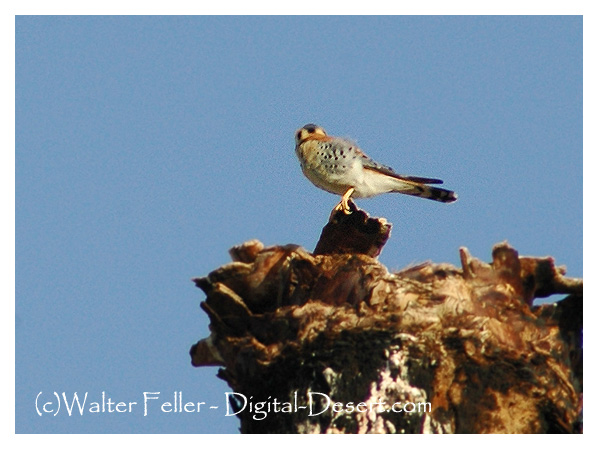--
American Kestrel
Falco sparveriusFamily: Falconidae Order: Falconiformes Class: Aves

DISTRIBUTION, ABUNDANCE, AND SEASONALITY
Common resident throughout California, wintering in all habitats except high elevations.
Also a winter migrant. Fairly common on Channel Islands. Occurs in most open habitats, in a
variety of shrub and early successional forest habitats, in forest openings, and various
ecotones.
SPECIFIC HABITAT REQUIREMENTS
Feeding: Takes small mammals, birds, insects, earthworms, reptiles, and amphibians.
Perches and pounces, pounces from a hover, or catches flying insects. Rarely pursues prey
on wing. Caches prey near nest in cracks in trees or rocks (Collopy 1973). Perch may be
tree, snag, rock, utility pole or wire, fence post (Grinnell and Miller 1944). Forages in open
habitats.
Cover: Seeks cover in a variety of cavities in trees, snags, rocky areas, banks, and
buildings.
Reproduction: Nests in cavities in trees, snags, rock crevices, cliffs, banks, and buildings.
Bent (1938) reported nests in cavities in sycamores, willows, and cottonwoods. Does not
construct a stick nest. Often uses cavities excavated by northern flickers and Lewis'
woodpeckers. In Oregon, Thomas (1979) estimated that the minimum dbh tree required by
these 2 woodpeckers was 31 cm (12 in) and 38 cm (15 in), respectively.
Water: Drinks water in captivity (Roest 1957). Has a high tolerance to heat and aridity.
Pattern: Forages in open and partially open areas of most habitats. Needs cavities near
foraging areas.
SPECIES LIFE HISTORY
Activity Patterns: Yearlong, diurnal activity.
Seasonal Movements/Migration: At higher elevations, moves downslope for winter and
upslope for summer. Individuals from north migrate into California for winter (Grinnell and
Miller 1944). Residents often maintain pair bond throughout the year.
Home Range: Prebreeding home range twlce as large as breeding home range on the
east side of the Sierra Nevada (Balgooyen 1976). At various other locations, winter home
ranges varied from 154-452 ha (380-1117 ac) (Enderson 1960, Mills 1976).
Territory: Balgooyen (1976) reported that 32 territories averaged 109 ha (270 ac). In the
Los Angeles area, Cade (1955) reported that defended territories averaged 10 ha (25 ac). In
various locations, summer breeding territories varied from 78-399 ha (192-987 ac) (Enderson
1960, Mills 1976).
Reproduction: Breeds from early April to August, with peak activity May and June. Eggs
laid mid-May to late June. Average clutch size 4-5, range 3-7. Incubation 28-31 days; young
fledge after 29-31 days.
Niche: May be preyed upon by larger raptors. Balgooyen (1976) suggested that tree
squirrels may destroy nests. May compete with other cavity nesters: woodpeckers, starlings,
owls, bluebirds, nuthatches, chipmunks, squirrels. Female larger than male, allowing pair to
partition food resources more effectively. Ectoparasites include lice, black flies (Roest 1957),
calliphorid flies, and milichiid flies (Balgooyen 1976).
REFERENCES
Balgooyen, T. G. 1976. Behavior and ecology of American kestrel (Falco sparverius L.) in
the Sierra Nevada of California. Univ. Calif. Publ. Zool. 103:1-87.
Bent, A. C. 1938. Life histories of North American birds of prey. Part 2. U.S. Natl. Mus. Bull.
170. 482pp.
Cade, T. J. 1955. Experiments on winter territoriality of the American kestrel (Falco
sparverius). Wilson Bull. 67:5-17.
Collopy, M. W. 1973. Predatory efficiency of American kestrels wintering in northwestern
California. Raptor Res. 7:25-31.
Enderson, J. H. 1960. A population study of the sparrow hawk in east-central Illinois.
Wilson Bull. 72:222-231.
Grinnell, J., and A. H. Miller. 1944. The distribution of the birds of California. Pac. Coast
Avifauna No. 27. 608pp.
Mills, G. S. 1976. American kestrel sex ratios and habitat separation. Auk 93:740-748.
Roest, A. I. 1957. Notes on the American sparrow hawk. Auk 74:1-19.
Thomas, J. W., ed. 1979. Wildlife habitats in managed forests: The Blue Mountains of
Oregon and Washington. U.S. Dept. Agric., For. Serv., Portland, OR. Agric. Handb. No.
553. 512pp.
California Department of Fish and Game. California Interagency
Wildlife Task Group. 2005. California Wildlife Habitat Relationships version 8.1 personal computer program. Sacramento, California.
Falco sparverius
American Kestrels are the smallest and yet most common falcon in North America. Lengths average 25 cm (10 inches) for females and 24 cm (nine inches) for males. Wingspans average 57 cm (22 inches) for females and 55 cm (21 inches) for males. Weights average 120 g (5 oz) for females and 111 g (3.5 oz for males).
American Kestrels are found in a variety of habitats including open fields, forest edges and openings, alpine zones, grasslands, marshes, open areas on mountainsides, prairies, plains and desert habitats with giant cacti or Joshua trees. In addition to requiring open space for hunting, American kestrels need perches to hunt from, cavities for nesting, and a sufficient food supply.
The American Kestrel is a Raptor. For more information on raptors, click here.
300-birds